Konyang: различия между версиями
>NewOriginalSchwann Нет описания правки |
>NewOriginalSchwann Нет описания правки |
||
| Строка 238: | Строка 238: | ||
[[The Trinary Perfection]] has seen mixed treatment unlike the [[Golden Deep]] on Konyang, with the planet’s government conceding that those affiliated with the synthetic church are covered under freedom of religion laws whether they are organic or synthetic. Although this has led to a relatively thriving community for the faith on the planet, with some of its most developed religious centers located on Konyang, the local government has a frigid relationship with the church, owing to its themes of IPC ascendancy running contrary to the local culture of equality. | [[The Trinary Perfection]] has seen mixed treatment unlike the [[Golden Deep]] on Konyang, with the planet’s government conceding that those affiliated with the synthetic church are covered under freedom of religion laws whether they are organic or synthetic. Although this has led to a relatively thriving community for the faith on the planet, with some of its most developed religious centers located on Konyang, the local government has a frigid relationship with the church, owing to its themes of IPC ascendancy running contrary to the local culture of equality. | ||
The most notable locations for the Trinary Perfection on the planet are the '''Cathedral of the First Positronic''' and '''Vault Provenance'''. The Cathedral of the First Positronic is a holy site that was built by repurposing a nearby vault. Meanwhile Vault Provenance, a name given by the Trinary Perfection clergy, was the vault which held the drones that led to the development of the first positronic brain. Tens of thousands of the Perfection’s faithful make pilgrimages to both sites, and the money these pilgrims inject into Konyang’s economy has been cited as another reason as to why the planet tolerates its presence.Trinary clergy are often educated on Konyang, and many of the highest-ranking officials in the faith were built on the planet. | The most notable locations for the Trinary Perfection on the planet are the '''Cathedral of the First Positronic''' and '''Vault Provenance'''. The Cathedral of the First Positronic is a holy site that was built by repurposing a nearby vault. Meanwhile Vault Provenance, a name given by the Trinary Perfection clergy, was the vault which held the drones that led to the development of the first positronic brain. Tens of thousands of the Perfection’s faithful make pilgrimages to both sites, and the money these pilgrims inject into Konyang’s economy has been cited as another reason as to why the planet tolerates its presence. Trinary clergy are often educated on Konyang, and many of the highest-ranking officials in the faith were built on the planet. | ||
{{Navbox Human Lore}} | |||
{{Navbox Lore}} | |||
[[Category:Planets_and_Systems]] | [[Category:Planets_and_Systems]] | ||
Версия от 07:56, 21 апреля 2022
Originally established in 2305 as a Solarian Alliance Outer Ring planet, Konyang is presently one of the more distant outposts under the Coalition of Colonies. Konyang’s capital city Suwon, the largest settlement on the planet, is built upon a natural formation that defines most of Konyang's geography: islands with large interior mountains that feature lush, but soaking wet, coastal jungle regions. Konyang was initially a relatively average Outer Ring settlement intended to export water, before the discovery of mysterious, deactivated drones in 2407 led to a robotics boom occuring on the planet that lasted well into the 2450s. The Konyang of today is a planet renowned for its robotics industry, though some of its initial luster has faded in the years following its boom. Water, however, remains a key industry - the planet has a remarkably low salination level, meaning that essentially all of its water is drinkable. Konyang Solarian Common, or Konyang Common, is the most used language on the planet inside and outside of major population centers. Due to its proximity to the Coalition of Colonies planets, Coalition member planets often import water from Konyang. In major cities and universities, Tradeband can be found being spoken, though it remains rare. Speakers of the language are generally from off-planet, moving to Konyang during its robotics boom. Konyang almost completely lacks valuable minerals due to intensive mining efforts carried out by drones—whose source remains unknown—hundreds of years before it was colonized.
Because of the ethnic make-up of Konyang's original settlers and assimilation of immigrants into the native population during the first AI boom, human characters born on Konyang will have appearances consistent with the people of China, the Korean Peninsula, and Japanese Islands. Only native Konyangers or Konyang-made IPCs may select the Konyanger accent. This is enforceable by server moderators and admins.
History
The once Solarian planet of Konyang was first discovered in 2278 by a long-range scouting probe, but was initially passed over for colonization due to the Interstellar War and the aftermath of the Second Great Depression. By 2298, the Solarian Alliance realized that more expansion was needed in the outer ring of its control to ensure its claims and keep a close eye on the Coalition of Colonies Systems near its frontier. By the start of the 24th century, efforts were underway to colonize the planet, with the first settlers setting foot on the planet in 2305, founding the city of Suwon. These settlers were primarily pulled from Earth's more economically depressed areas. Colonists from East Asia were tapped in particular, lured to the frontier of Solarian space by the promise of a better life.
These initial settlers to Konyang rapidly realized two things. First was that the planet was almost completely freshwater, which was a massive boon for the original colonists. Second was that the planet almost completely lacked valuable minerals, with preemptive drilling operations finding paltry amounts of iron, and evidence of collapsed mining tunnels. The reason for this utter lack of resources would not be discovered until 2404, when a surveying team uncovered a technologically advanced drone of unknown origins within a partially collapsed mining shaft. Though corroded by centuries underground, the drone was intact enough to be brought back to a facility in the nearby city of Point Verdant, and reported to Sol government authorities. Sol auctioned off the rights to the drone, with Einstein Engines winning the bid. The drone was transported to a Terraneus Diagnostics prefab facility built on Konyang which then took on the project.
Despite the lack of minerals, the nigh-unlimited supply of freshwater, clean air, and arable, if limited, land led to a decently sized colony centered mainly around agriculture. Keeping in line with its original purpose as a listening post for the Sol Navy, the 58th Fleet was stationed in the colony, resulting in a modest but prosperous shipping industry to sustain it. Its position along the border with the Coalition was one of the factors that led to the construction of a bluespace gate decades later.

Over the following years, Terraneus Diagnostics engineers and scientists in Point Verdant gradually began to piece together more and more about the drone. By 2405 carbon-dating had placed the drones within the Skrellian Glorsh era, though the true source would remain unknown and their designs failed to match with any previously known robotics. On their part, the skrell refused to comment on the matter, dismissing it entirely. More drones had been found in the intervening years, all in various states of disrepair. After centuries of exposure to nature there was simply not enough to salvage the AI routines of the machinery. Mining equipment was improved by analyzing the construction of the drones but the true crown jewel, the AI on-board, remained frustratingly elusive. However, in 2406, everything changed through utter happenstance.
In the middle of the dry season a Terraneus survey team searching for more drones to pick apart stumbled across an odd structure: a cave blocked off by an airlock of titanium. Aware that the planet was home to the mysterious mining robots, they cautiously opened the door to see what was on the other side. On the other side of the door were rows upon rows of preserved mining drones sealed inside a climate-controlled repair bay for centuries of inactivity. The severity of this discovery was immediately apparent to them. Words were had with the governor of Konyang by the local Einstein Engines representative, and it was decided to keep the drones a very closely-guarded secret - with only select Terraneus and government officials even being aware of their existence at all, let alone what was being done with them.
The Terraneus research team worked feverishly, though in secret, for months upon months. Staff were quietly shipped in from offworld in order to not alert outside observers, and the team continued to work upwards of eighty hour weeks in order to crack the drones. In mid-2407, they achieved one of the most remarkable breakthroughs in recent scientific memory by cracking the AI algorithms of the drones. Information of this moved rapidly from the local Einstein Engines office up the corporate chain and moved equally rapidly up the government's chain from provincial office to Sol itself. The information spread like wildfire, and humanity now had the secret of AI despite not truly knowing from where or who these machines came from. This was little more than a footnote to the Jargon Federation - to them, these AI were crude and hardly approached the machines that had driven their civilization to ruin.
The robotics boom of Konyang caused a variety of benefits and harms to the previously marginal outer ring planet. The economy ballooned massively, as did its standard of living and industries. Konyang moved from a rural backwater that exported food and water to a high-tech planet that still exported basic goods, but primarily focused upon robotics. Megacorporations flocked to the planet: Einstein Engines, already present through Terraneus, rapidly secured dominance over the planet; Hephaestus Industries struggled with Einstein dominated competition before selling its factories over to local government control in 2427; and Zeng-Hu Pharmaceuticals, despite its skrell benefactors, purchased rights to examine the planet's biosphere from Einstein. The fact that their prosthetic limbs were originally designed on this planet has been stated to be a "happy coincidence" by its board. Due to the mass arrival of corporations, jobs were readily available - the planet was booming.
But, not all was well. The rapid expansion of Konyang's industries and cities had overtaxed the limited bureaucracy on the planet to the breaking point, and architects were in short supply. Urban planning on Konyang is estimated to be some of the worst in Alliance space outside of New Hai Phong as a result, with cities such as Point Verdant often having haphazard roads running through them and districts smashed together with no apparent rhyme or reason - a legacy of corporate jockeying for areas of interest, and the municipal corruption that came with it. There are countryside facilities originally utilized for drone research and retrieval that have, in recent years, fallen into disuse and disarray. Such facilities often dot the mountains and foothills of Konyang, slowly being overtaken by nature - sometimes with unfortunate results when these facilities have been improperly stripped of dangerous materials. The environment also suffered in areas where drones were found - jungles were cut or burnt away by corporations in order to get at the precious drones below, prefab buildings were orbitally dropped and erected, and landing zones were cut into the landscape itself. Many colonists on Konyang, which made their livings off of exporting water, became frustrated with this. They were almost universally ignored by the local government, which was (and is) receiving a great profit from the booming robotics industry.
Though the robotics boom has declined since its peak in the late 2440s, it remains a large employer on the planet. Konyang produces many of both the brightest roboticists and two of the most renowned robotics universities in the Coalition of Colonies- the Suwon Solarian Institute of Robotics Research, a now independent university, and the Point Verdant Terraneus Institute of AI Research, a corporate university - can be found here, along with their famous rivalry. There is even talk of the Point Verdant Institute rivaling Solis Cognito in recent years, much to the joy of its sponsors. Hydroponics - in the form of waterfarms and literal water - remains an important, though secondary, industry on Konyang.
As the phoron crisis worsened and Sol’s collapse grew nearer, tensions could be felt throughout the middle and outer colonies. Following the departure of the 58th Fleet from Solarian space, Konyang entered a five day period of silence. Once communications were reestablished, Konyang declared itself an independent state, seceding from the Alliance and joining the Coalition of Colonies shortly thereafter. Although the planet’s liberal view on synthetics has made for easy integration with the Coalition of Colonies, tensions between Konyang and Burzsia have been observed.
Now, as a free Konyang comes out to the world stage, strong government initiative has seen its large synthetic factories nationalised, rapidly introducing legislation to establish the relationship with Einstein Engines. While they still are the dominating megacorporation on the planet, Einstein has lost most of its heavy industry, though still retaining the important research facilities around the vaults, as well as a good portion of software and positronic brain creation.
Life on Konyang
The Konyang of the 2460s bears little resemblance to the minor colony of 2305. Expansive cities dot its islands, with everyday life flowing very similarly to other advanced societies abroad. However, cities outside of the more famous robotics research and production centers have a lower standard of living, with most being employed in water-related industries or manufacturing jobs. Even worse, many of these former "boom towns" of the robotics industry are entering into a spiral of decay due to an inability to continue to maintain their buildings and utilities due to the sheer price of importing materials from offworld, which has led to a flight from small to moderate sized urban centers into major industrial cities - worsening an already-existent problem of overcrowding.
A lack of raw materials on the planet means that prices on fabricated goods are often exorbitantly high, only kept down by generous government subsidies. Most Konyangers in the large cities own a small apartment - often called a "shoebox studio" - at best, with only the extremely rich having buildings of their own. Streets, already chaotic due to the quickly-built nature of Konyang's urban centers, are typically snarled in traffic due to overcrowding. The snarled traffic is, in an odd way, a symbol of pride for some Konyangers. The mere fact that they have enough vehicles to have traffic issues is, compared to the rest of the outer ring, a symbol of the prosperity that has resulted from the planet's robotics industry.
Life on less populated islands and areas is generally regarded as more carefree, with coastal villages being relatively self-sustaining and free from the complicated stresses and cramped environments found in cities. Such settlements are dedicated almost entirely to aquaculture, farming fish and algae, as well as moss. Surprising as it may be, many IPCs find themselves in these communities, finding work in manual labour or in the fields. It is not uncommon for a village to possess a repair shop and charging stations dedicated to synthetics. Much care is also given to keep the traditions of the original colonists alive, with old rituals and festivals thriving and sometimes only found in the rural villages. The government is very supporting of such customs, not only for the planet’s cultural heritage but also as an important tourist attraction.
Konyang’s high population density and disparity in standards of living have only been worsened by waves of refugees from the Human Wildlands. Plentiful reserves of food and water have ensured that the planet remains a popular destination for anyone attempting to escape the conflict now gripping the Sol Alliance despite a lack of resources or infrastructure to take care of them. The quick solution of Konyang’s government came in the form of very harsh immigration laws. The bare minimum of aid is provided, with food, water, and basic shelter offered in refugee camps controlled by the army on sparsely populated islands. From there, refugees await their relocation to a different Coalition planet. Although those with special skills, especially in the fields of robotics or agriculture, are often sponsored by Konyanger corporations to gain residency, the vast majority of them are regarded with mistrust or condescension; being seen as threats to the harmony of Konyang, or as freeloaders.
Local businesses exist on the planet, and in some cases, may even thrive, but are more than often eclipsed by Einstein Engines. The megacorporation owns a number of subsidiaries on the planet in many different sectors, most notably, Terraneus Diagnostics, which regularly bankrolls and invests in government initiatives in exchange for their continuous presence, retaining of their original research facilities and control over the vaults, even if IPC production and exports are now handled by state run companies. They occasionally butt heads with Zeng-Hu Pharmaceuticals, especially in the realm of IPC research, though the former retains minimal influence when compared. The Terraneus facilities on the planet mainly handle shell research and positronic brain production for export to the Coalition.
Government
Konyang is organized as a federal parliamentary democracy headed by a ceremonial President, the former colonial governor Hyun Kyung-Ho being elected to the position after independence. The prime minister is elected by the free citizenry every four years, and is the leader of the governing party in the Parliament of Konyang.
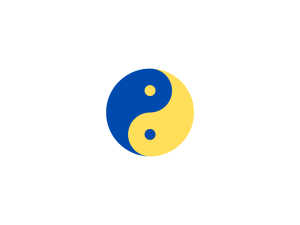
Due to the geographical isolation of many of its islands, its cities developed as mostly independent regions. As such, it is now organized along the same lines, the planet being divided into five largely autonomous Prefectures, each headed by an elected Governor and a government-appointed Prefect for federal matters. Although there are laws at the federal level, prefectures are given a great deal of autonomy when running day to day affairs, each having its own legislature and executive. For instance, each region often maintains its own public services, with the central authorities only stepping in when the local government has proven unable to meet the standards set by federal law or the constitution. The most prominent piece of federal legislation in effect is the equality of synthetics and organics.
The legislative branch is comprised of the Parliament of Konyang, seated in the capital city of Suwon. Elections are held every four years with parties contesting the 300 seats. Members of Parliament are elected on a prefectural level, each prefecture assigned a fixed number of seats based on population. This arrangement, while seen as satisfactory by the majority, is regularly criticised by the politically active IPC community in the country as “biased and unfair”.
Planetary politics are found on both a national and prefectural level, with almost every party running in local and national elections. Polarisation is fairly limited, the vast majority of Konyangers rejecting the extreme views put forward by radical political movements in the country that tend to be marginalised. IPC politicians do exist and are found in every major party, though most can be seen sitting with the National Party of Konyang, a pro-synthetic movement, run by and representing the interests of the IPC population, currently leading the opposition with a large 32% of the vote.
Despite its federal nature, Konyang has a unified law enforcement organization, the National Police. It focuses mainly on preventative policing and building rapport with local communities, relying on a sense of civic duty from the populace to perform its duties. Notable in the Spur is its Special Robotics Division; a task force raised for the purpose of developing ways to detain IPCs without causing permanent damage.
Konyang and the Coalition
Shortly after its independence in late 2462, Konyang successfully applied for membership in the Coalition of Colonies in order to gain steady trade partners and better protect itself after the sudden collapse of the Sol Alliance. Readily accepted owing to their strategic position and innovative robotics industry, the planet’s relationship with its new partners quickly flourished based off of a mutually beneficial exchange of resources and information - Konyanger engineers, scientists, and technical designs now finding themselves prized throughout the Coalition. Common goods traded between the planets include vast amounts of moss, seaweed, and algae to feed lesser-off colonies, particularly in the Frontier, in exchange for raw materials. The planet’s military also finds itself frequently consulted when dealing with border patrols in the Solarian Wildlands, owing to their familiarity with the rest of the Alliance.
Despite the rosy relationship Konyang now shares with the Coalition, the planet has refused to compromise on the topic of citizenship, insisting that Coalition citizenship only grants temporary access to the planet, the local government being given the authority to bar or allow all entrants. This move has been cited by observers as driven by the sudden influx of refugees and IPCs from the Sol Alliance, while others cite Konyanger cultural closed-off attitudes as the government’s motives.
Consequently, outside of tourists and refugees, Konyang only accepts residents and citizens under the following criteria:
- Residents must have a work visa, only furnished by online, off-planet request when sponsored by a Konyang-based employer, or have family on the planet.
- In order to apply for citizenship, a resident needs to have lived on Konyang for 10 years, be financially self-sufficient, and have committed no felonies.
- Organics and IPCs are equally eligible to apply for residency or citizenship.
Military
Konyang’s military, also known as the Konyang Armed Forces, was first formed shortly after the colony’s independence from personnel of the former Solarian garrison. As a result, it carries a lot of the traditions of the Solarian Armed Forces. Bolstered by conscription laws requiring both organic and synthetic citizens one year of mandatory service, the KAF possesses Army, Navy and Space branches. IPCs are actively recruited and accepted into the military, mostly forming their own units. This segregation is justified by the government as based solely on the differentiating capabilities, logistical needs and skills between man and machine.
That claim does hold true to an extent, with IPCs taking a more active role in special forces formations, dealing with operations requiring levels of precision and focus that artificial intelligence can easily provide. A famous example is the army’s Mechatronic Corps, an elite unit utilising large, leftover battle mechs retrofitted for a pair of pilots. Such a force is unique in the Coalition, and is often used abroad in operations under broader CoC military command. Mixed infantry units of conscripts do exist, fielded in border patrol tasks or assigned garrison duty.
Notably for a 25th century military, the Navy maintains a very large aquatic force which it uses to patrol the vast oceans of the planet. Regularly described as more of a coast guard than a military arm, it is more geared for domestic policing than combat, consisting mostly of ships acting as launching points for many smaller, coast guard type patrol vessels. that patrol the vast expanse of the planet’s waterways and launch military aircraft.
Its spaceborne element consists of obsolete vessels donated by Coalition planets, partially brought up to a modern standard by the planet’s technology and manufacturing sector. In 2463, the KAF’s main tasks include protecting the Republic from pirates and policing the large influx of refugees from the Human Wildlands, regularly pushing them to other planets within the Coalition as per Konyang’s strict migration laws.
Culture
Konyang’s culture has been shaped by its East Asian Earther heritage, unique status as a colony with little to no resources, and as the birthplace of positronics. Konyanger society is often described as closed-off, with many unspoken social norms that vary from prefecture to prefecture.
Key social norms that are shared in Konyang’s culture are Harmony, Reciprocity, and Face. Often derided as “meekness”, Harmony refers to enforcing unity and conformity within society. The specific manifestations vary from prefecture to prefecture, but in general, individuals who disrupt a sense of peace can face social ostracization. For instance, explicit disagreement such as using the word “no” is considered impolite, and a non-answer is often far more acceptable. Harmony also refers to a person’s social role; respect should be shown to people of a higher status, usually along traditional lines such as age, profession, and experience.
Reciprocity is based on the idea that a good turn should lead to another. This norm leads to the development of tightly knit social networks, where Konyangers are expected to look out for each other in all spheres of life, be they personal, professional, or political. It is believed by some Konyangers that the cultivation of these values in their IPC citizens is partly responsible for the close integration they presently share with organics.
Tying these social norms together is Face, a catch-all term for a person’s pride, social perception, prestige, and reputation. In Konyang, a person’s “face” is increased when they can uphold social norms and preserve harmony. It can also be bolstered in other ways, such as by a more reputable person’s endorsement. Face is regarded as incredibly important for all interactions as a loss of face can result in social isolation, or in the case of business, a loss of opportunities, until such time that “face” can be regained.
Formerly part of the Outer Colonies, outsider influence on the planet’s culture was largely limited to Solarian navy personnel and their families until The Robotics Boom in the late 2400s to 2430s affected the cultural makeup of the planet significantly. Large numbers of workers, scientists, and engineers were brought to study and exploit the discovery of alien robotics, bringing their traditions with them. Although some left with the end of the Robotics Boom, expatriate communities have formed, often staying in close groups, accepted by Konyanger society, but not as Konyangers themselves with terms like “Coalition-Konyanger” being used.
The world’s entertainment industry is quite developed and popular within the Coalition. Consumed mostly in the cities, animations are the most viewed entertainment media produced and aired on Konyang, many locals even preferring them to regular films. By far the most famous and successful studio, Konymation, remains a staple in everyday life, employing thousands throughout the planet in drawing, voicing and animating high budget movies and series of all kinds and genres. Konyanger animations are also popular in many neighbouring Coalition and Sol worlds, while generally finding themselves regarded as an exotic niche the further one gets. More conventional entertainment, especially Solarian in origin, is mainstream in Point Verdant. The city’s roots as a settlement for Einstein Engines and other companies’ employees has resulted in the import and establishment of foreign cultural elements, cuisine and ways to pass the time.
The primary language spoken in Konyang is a dialect of Sol Common known as Konyang Common. It derives loanwords from many languages, such as Freespeak, in particular. The vast amount of technology present in the planet, as well as the unique nature of communities means a Konyangers can get by speaking only a single language fluently, relying on computer translation to make up the difference. Other common languages on the planet include Freespeak and Tradeband, brought by decades of contact and the Robotics Boom, respectively. Most IPC citizens on Konyang are also programmed with Encoded Audio Language, although its usage is discouraged when among organics.
Fashion
Being as moist as it is, one would expect the average Konyanger outfits to consist of drysuits and reflective outerwear, with raincoats and the like. This is the case in the majority of urban settings, whereas people in the villages take quite their own unique spin on their fashion choices.
Insulation from water is difficult to come by without some form of thermal insulation coming with it. This is clearly suboptimal, seeing as beating the heat is just as important as staying dry here. In their ingenuity, rural Konyangers have utilized a “miracle weave” of natural fibers acquired from the feathers of much avian wildlife planetside. Replicating the byproducts of these feathers has proven impossible, leaving only hunting to produce the necessities for the weave. Traditional villages take immense pride in their unique attire, many calling it the most important difference between them and the cities. Combining vibrant colours and utility, Konyanger fields are regularly dotted with farmers sporting colourful ponchos, robes and traditional Gat headwear. Most rural Konyanger “fashion” draws from this weave in some form - resulting in cool, waterproof, and sharp-looking outerwear resembling a poncho in most cases. More complex items such as jackets and legwear are quite expensive and marketed as luxury items for the elite, with the weave still in quite high demand.
Urban fashion on the other hand is rather detached from the realities of that of the villages. The natural, feather based fabrics are rarely found amongst the denizens of the large cities, while those who do own them are quickly singled out as either people from the countryside, or individuals of a higher class. Rainy weather still being the primary issue, city dwellers have adopted a different stance, preferring clothes of industrial origin.
In combination with normal everyday clothing items, these Konyangers have adopted a heavy use of water resistant plastics. Stemming from the first years of settlement on the planet, plastic and translucent raincoats were slowly shaped into all sorts of jackets, coats and pants, creating a more comfortable and utilitarian approach to keeping clothes dry. Slowly developing into a fashion sense, and with research on more flexible materials, plastic-based attire has culminated into being the norm. LED lights, translucency and water resistance are the staples of this trend, the youth and clothes designers taking it a step further, with holographic microprojectors being woven and fluorescent substances infused into the material, creating quite the cutting edge in fashion.
Cuisine
The primary diet of Konyangers consists of moss, seaweed and fish, with farms and pastures on land being rare due to the thick jungle. Konyang's moss is either harvested in the wild, grown in "natural" hydrofarms, or grown synthetically in bioplants. The moss itself is said to change its taste depending on the environment in which it is grown, and natural moss from the coasts around Konyang's islands is highly prized. Exports of moss and seaweed are a very lucrative business, held primarily by the galaxy-famous Go-Go Gwok! brand. Many workers, however, must make do with hydrofarm moss at best, and synthetic substitutes at worst. Konyang's fish - quite diverse, due to its freshwater environments - are also often consumed on the planet, with many being exported as luxury food as far afield as Venus and Tau Ceti. More conventional but water-intensive crops such as rice and other tropical fruits are also grown to a certain extent but are considered a rarity.
The planet is also home to a thriving beverages industry, with local varieties of algae providing the basis of a light but thick alcoholic drink colloquially known as “Nong jiu” domestically and abroad. The wide selection of produce on the planet however means more traditional drinks are produced, typically drawing from their Earther roots and commonly based on rice. Some of these drinks are exported by local businesses such as Go-Go Gwok! while Zeng-Hu has wrestled to control some of these brands in an attempt to stop them from competing with their own lineups.
Synthetic Cuisine
Synthetic-unique cuisine is an unusual case in the Spur, but not for Konyang. Here, robots utilize gustatorial implants to - if inefficiently - consume, or at least “taste” food regularly. Indeed, there is an entire market for synthfood where robots can enjoy their own form of taste, texture and uniquely perceptive flavor for foods. Mostly, synthfood is described as a thick slime, one with varying additives for color. Texture is mostly a simulated process within gustatorial implants, given they are not always present on tongues alone - meaning that the actual texture of these synthfoods remains the same gooey substance.
One can achieve a similar substance to these synthfoods mechanically by grinding certain foods into paste, or utilizing candy machines with your choice of ingredients and output.
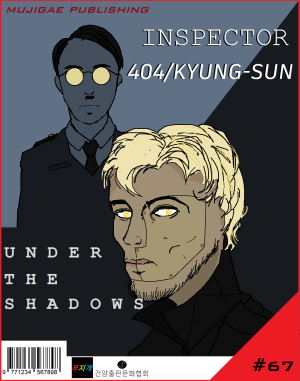
Media
Public media in Konyang is a powerful industry, and as broad as it may seem, it is very tightly knit. Aside from galactic-wide reruns and broadcasts of other nation’s shows, little seems to stand out - except the audio broadcast and illustrated artistic avenues. These two are well-refined artistic giants compared to other forms of entertainment on the planet.
A huge portion of the planet’s political views and very “personality” are channeled through its larger studios, where many are found enthused to spread its culture galaxy-wide.
Audio Broadcast
Radio, or more broadly the global net of wireless communication, is a huge industry in Konyang. Many IPCs have found harmless additions to their daily lives to be the standard headset and wearable radio kit, permitting any number of fast EAL communication planet-wide streamed directly into their receptors. While not particularly lucrative, the major broadcast stations have made quick work to monopolize their grip over this method of communication. As a result, only two major audio broadcast nets total exist on Konyang.
Matsumoto’s Talk and Walk
Meant for the on-the-go working IPC, this Encoded Audio Language bluespace broadcast is run by a particularly energetic “Matsumoto.” Though the true nature or even appearance of Matsumoto is unknown, they have constructed a massive following built from IPCs who obsessively strive to uphold their strict, rigid lifestyle. Talk and Walk states clear affiliation with multiple government and corporate organizations, particularly those with Hephaestus Industries. Matsumoto will often promote charitable foundations or corporate products found on Konyang, especially to those tuning in to their tourist-centric broadcast. When speaking in Sol Common, they take on a fast-paced and high-pitched masculine tone. They are frequently put on loudspeakers in popular tourist destinations, with recordings accompanying stylized eyeballs which track passerbys.
Great Blue Dot
Hidden somewhere in the depths of Konyang’s shallow seas is a moving, unseen broadcast station which has gone undetected since its first broadcast in 2430. It is known as the Great Blue Dot, attributed to what researchers believe to be its tremendous size and the color of its marker on sea-charts. While itself illegally broadcasts to every openly-receiving piece of hardware on the southern hemisphere of the planet, little can be gleaned of the actual broadcasts themselves. From incoherent gibberish of “swarms of wasps,” to “hives in the skies,” the outgoing material is poorly formed at best. Receiving these broadcasts is not illegal, contrarily, and the sheer number of watchful eyes bouncing back to the broadcast keeps its location perpetually hidden from local authorities. Search efforts for the source of the Great Blue Dot stopped in May of 2462, due to “excessive cost for little reward,” police officials say.
Visual Animation
Animated media is commonplace on Konyang, and chief among the many outlets that enhance its unique culture. Whereas hundreds, perhaps thousands of animated studios take up projects annually, very few make critical success. By far the most famous and successful studio, Konymation, remains a staple in everyday life, employing thousands throughout the planet in drawing, voicing and animating high budget movies and series of all kinds and genres. The industry, despite computer-aided assistance, heavily leans on IPC labor and organic oversight for its newly-animated creations. This makes it very costly, and few endeavors pay off. Some examples of those that succeeded are below.
Stormman
A very popular series created by Konymations, Stormman has been described as a staple animation by both human and IPC audiences. Aimed primarily at young adults, the action packed franchise features the masked protagonist, Stormman, harnessing the power of Konyang’s stormy and thunderous weather with his high-tech suit, battling crime and apocalyptic alien invaders alike, all while trying to lead a normal life. Eight seasons have been released so far, whereas merchandise of all sorts are widely prominent as well as lucrative.
Believe!~ (In the Time)
A hit animated series renowned for its choppy, quick action sequences led by a stoic heroine by the name of Marie, a time traveling Venusian shell IPC from the 2460’s. Targeted primarily at IPC audiences, it takes place in the pre-war “wild west” Frontier at around the early warp era. Being released in 2435, it has claimed fame as a “hit 30’s classic,” still being aired on prime broadcast stations globally in subtitled Sol Common. To organic viewers, much of the dialogue, tones or consistency is said to be lost in a muddle of incomprehensibly fast shoot-out scenes and plot twists that happen for split-seconds.

Comics
To preface the animation industry’s giants usually comes a smaller version of itself in the form of Konyanger comics. These, in a sense, are what animated shows evolve from and are arguably more popular than animated shows thanks to their ease-of-consumption in the form of carried booklets. Comic books are a titanic industry on Konyang, and perhaps the largest of its kind to exist in any civilized world in the Orion Spur.
Inspector 404/Kyung-Sun
Since its debut in the issue “Phantoms of Suwon,” the series simply referred to as I404 is the most popular comic in the Orion Spur, and Konyang’s most profitable media franchise. The series centers around the titular Inspector 404, a shell IPC who goes by the alias of Kyung-Sun, in a bleak and highly dystopian Konyanger cityscape. While the series itself starts upon a Suwon highrise, the character would go on to travel the world in its 67 current issues. Issue #67, known as “Under the Shadows,” revolves around the Kyung-Sun going up against the same police establishment he had been serving, pitting himself against corrupt police superintendent Hayashi.
Konyanger Augmentation of IPCs
Augmentation on Konyang is a fascinating subject, where the presence of so many IPCs has brought success in modifying the Positronic body and mind. Famed explorations into the sectors of IPC modification include "sensory evolution," where synthetics' senses being amplified or dulled in extremes according to desire.
Primary among the delves into this evolution of the senses is the New Dawn Augmentation Movement. This is a Konyanger organization based on the improvement of the IPC lifestyle via modifying chassis, funded peculiarly by Terraneus Diagnostics. The movement is oddly organized as a non-profit, going against the corporation’s established modus operandi. This, coupled with the tantalizing opportunity to freely modify an IPC's form with donated funds leads to public skepticism of the augment movement’s motivations.
Still, the true size of the movement to augment and improve Konyang's IPC population is extraordinary in comparison to other stellar nations. Roughly 22% of Konyang IPCs have some form of corporate-funded augmentation to enhance themselves.
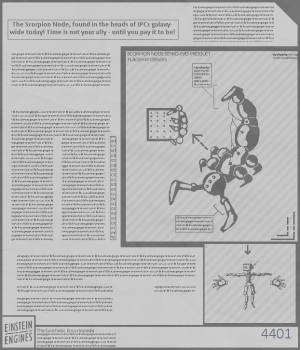
- SENSO-EVO/Scorpion Lobe
A miraculous creation of Konyang's technological advancement, SENSO-EVO is the term aptly handed to Sensory Evolution's foremost product. This is the Scorpion Lobe, a similarly shaped attachment to the rear of a positronic brain which adjusts the rate at which the synthetic perceives time literally. The implications of this are seen as either a blessing or a curse — sometimes even utilized as a way to reduce problematic behavior in positronics.
These implants are commercialized to protect the integrity of brains which adopt extremely high speed tasks, or extremely tedious and slow ones, with a perception that best suits their given utility.
A double edged sword by nature, these are often removed by free positronic chassis due to their almost torturous nature. Some may find their lives flashing hours into moments, whilst others may find daily grinds to be impossibly long ordeals. Unfortunately, removing these implants is not always a safe procedure, sometimes damaging a brain or rendering the problem worse.
These were first manufactured by Hephaestus Industries on instrumental Konyang research facilities, and later acquired by Einstein Engines personnel in the same month - debates over the design’s origin have been ongoing since 2449.
Work Culture
Konyang’s emphasis on self-reliance, combined with the presence of IPCs in the workplace has resulted in a very demanding work culture in the cities. Konyanger employees are always expected to put in more hours to remain competitive against their synthetic counterparts, many of them willing to go to far greater lengths than what is healthy or required by their employer. The issue, particularly in Suwon, has grown to such an extent that local laws were passed, limiting IPC overtime work as well as making leaves mandatory for them in order for humans to catch up more easily. Such legislation has been fiercely debated as unconstitutional and infringing on the rights of synthetic citizens, nonetheless remaining in effect as a temporary, much needed measure. While a strong work ethic is a very common trait, the rural populace is generally more relaxed than their urban counterparts.
Environment
Konyang features a highly atypical environment for a habitable planet: it is entirely freshwater. The surface of the planet is primarily water, with estimates placing upwards of 88% of the planet as covered in water. What is not covered by freshwater are the islands of Konyang, where the vast majority of its population lives. These islands follow a general pattern: a small coastal area and a large mountain range ringing the island. The freshwater oceans of Konyang feature a remarkable diverse biosphere, and Konyang underwater flora, such as freshwater moss, is often used in the planet's native dishes and exported offworld, as far afield as Sol and Tau Ceti. Konyang is defined by two seasons: wet, lasting nine months, and dry, lasting three months.
The coastal regions of Konyang represent the smallest regions of its islands, but contain upwards of 90% of the planet's population. Often called the "coastal jungles" of Konyang, these areas are extremely wet - flooding is an issue in some areas, though the bulk of populated and urban areas are protected by extensive flood protection infrastructure, primarily lengthy complexes of walls. Coastal areas feature a wealth of plant and animal life, both of which have been put under stress by the rapid expansion of Konyang's cities.
Although Konyang’s coastal waters are often tinted green from moss, even more so than its oceans, harvesting and cleanup efforts along the coasts of the main and important islands have resulted in some sections of the planet appearing blue. These areas are often exploited for settlements and as tourist destinations for their scenic looks, while dedicated seaweed and algae farms dot the planet, providing an income for local villages and traditional producers. The most famous Konyanger food exporter, Go-Go Gwok!, has the largest involvement in the moss and seaweed industry.
The inland mountain ranges of Konyang can be up to several kilometers in height in some areas, with smaller foothills featuring some rare settlements leading up to them. These ranges, which lack valuable minerals completely due to Glorsh-era mining, are the reason for Konyang's jungles - they form an effective rain shadow. Some mountains have what is assumed to be collapsed mines in them, deactivated drones scattered throughout.
A phenomenon unique to the easternmost islands of the Geinjohada district, inland deserts are created due to the rain shadow caused by the surrounding mountain ranges. These are the least populated areas of the planet. Extraordinarily dry, little grows or lives in these environments. Rare Zeng-Hu Pharmaceuticals facilities can be found in this area, taking advantage of the isolation and relatively sterile environment that the inland deserts offer.
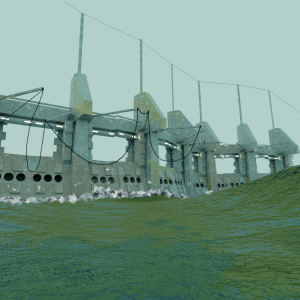
Lastly, the oceans of Konyang are regularly stormy, the large waves being harnessed for their energy in electricity production at numerous such outposts, scattered throughout the unpopulated islets in the farthest and most secluded areas.
Flora and Fauna
Wildlife on Konyang is a peculiar mix of its original environment and the thousands of invasive species introduced by Human colonization. Species introduced in the initial colonization of the planet include huge herbivores and peaceful, if ecologically destructive, wildlife.
Flora on Konyang is among its most famed aspects, spearheaded by the mossy shores and overgrowth which covers the vast majority of its visible terrain. All plant life which survives on Konyang must survive the extremely damp environment, and as such either thrives in the water, or is capable of moving away from it.
Shelfers
In the marsh and lowlands of Konyang's algae coasts resides an invasive species of large omnivores known as Shelfers. These are gluttonous moss-feasting beasts, with a distinct six-legged and bloated appearance. They are excellent swimmers, owed to webbed joints and a wedge shaped, slick head. From this, it uses a set of large protruding teeth to scrape moss and undersea growths.
This creature is endangered, and displayed as a national animal thanks to its unique appearance. Originally a danger to unprepared colonization, these gained a reputation for its tendency to attack colonists.
These were first encountered by colonists who had shipped wildlife to and from Arusha, where escaped subjects managed to reproduce- over the years becoming a cultural icon due to their miraculous beneficial place they have in Konyang's ecosystem.
Konyanger Jeweler Cockatoo
Known for its affinity to decorate its nesting grounds with surface-level pearls and gems of all sorts is an opportunistic carnivore, the Jeweler Cockatoo. This large avian is an offshoot of the Earth parrot, bred originally to “liven the landscape” of Konyang’s dreary inner mountainous lands. Eventually, with the assistance of high-level genetic modification, they grew to giant proportions whilst maintaining the health and lifestyle of a standard - if highly dangerous - parrot.
Where small patches of forest and barrens clash, these birds thrive and craft beautiful roosts in the relative safety of open fields. In these fields, diminutive predators avoid the large avian’s glare (or don’t, and are frequently preyed upon.) The Jeweler Cockatoo possesses two sharp talons on one digit of each of its feet, and a short - but unbelievably sharp beak, refined further by its tendency to dig. The wingspan of these birds can grow up to fifteen feet.
The Jeweler Cockatoo is the national bird of Konyang, with many stylized imagery depicting the bird in some shape or form.
Glittering Konyang Moss
Found in vast plains of coastal territories in excess is the overflowing, yet precious resource of Konyang moss. One of its primary exports, this barely-tapped commodity retains a huge capacity to feed Konyang’s already sturdy ecosystem, and the billions which reside upon it, and more to export. The evolutionary process which grew this mystical, shimmering moss is a mystery, however its luster and fields of green it generates has a wonderful impact on sustaining Konyang’s moist, overgrown and greenery-rich habitat.
Konyang moss is pivotal to its moving industries, and even after the robotics boom, it remains a stable source of incoming development for the since-burgeoning planet. The moss’ nutritional properties have been highly studied in recent decades. Its rapid pace of growth is exclusive to Konyang’s ecological circumstances, with everything from subterranean heat, to the algae present in its beautiful green seas factoring in.
Population and Major Cities
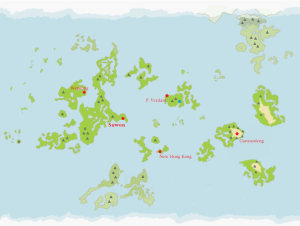
Suwon is the largest, most populated, and second wealthiest city on Konyang itself and is generally one of the larger cities in the Coalition of Colonies. It functions as both the planetary capital, as well as the capital of Suwon Prefecture, encompassing the entire island. Symbolic of the new government is the Parliament Building, a massive structure of flowing lines and sustainable technology, incorporating pieces of the first colony ship. The Solarian embassy, as well as embassies from various Coalition states are present here as well. Standards of living in wealthiest areas of Suwon are equivalent to and (sometimes) even surpass the living standards of places such as Highland City or Argia sa Mar, demonstrating how wealthy the robotics boom has made some sectors of the planet. A lack of readily-available materials, however, ensures that even the super-rich of Konyang often live in smaller houses than their Colonies planet counterparts. Life outside these wealthy areas is better than life in most cities in Himeo but dramatically worse than in the very wealthy areas, or even the cities of Xanu Prime. Overcrowding is a massive issue for the government of the city, with no obvious solution presenting itself due to how expensive importing new building materials is post-boom. "Shoebox apartments" are common here, as are Konyang's often egregious traffic issues. The city is fortified with extensive sea walls, flood walls and flood gates to prevent natural disasters during the wet season, tropical storms being fairly common.
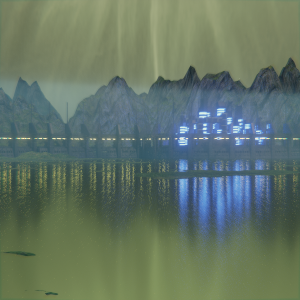
Point Verdant is the second most-populated city on Konyang, and the industrial heart of its robotics industry. It is by far the wealthiest city on Konyang, and one of the richest cities in the Coalition of Colonies. Point Verdant is home to the renowned Point Verdant Terraneus Institute of AI Research, and is the poster child for the rapid development of Konyang's cities during the robotics boom. The city is extremely wealthy, but suffers from persistent overcrowding and traffic issues in all of its districts. The Pusan District, near PVTI, had the reputation of possessing the worst traffic in the Alliance according to its residents. Air quality in Point Verdant is regarded as subpar, due to the amount of robotics factories within the city itself. Being one of the focal points of the Robotics Boom, it is home to a large number of expatriate communities and Einstein Engines employees.
Boryeong, named after a city on historical Earth where some of its colonists originated from, is the third most populated city on Konyang and the center of its hydroponics industry. The city, while still suffering overcrowding issues, has it to a lesser extent than Point Verdant or Suwon, with the hydroponics farms and water plants necessitating a need for space. Water bottled in Boryeong is sold throughout the Alliance and Coalition as Konyang Water, and native moss grown in and around Boryeong is sold throughout both as a luxury food. Synthetic moss is grown in Zeng-Hu facilities near Boryeong and, despite being regarded as lesser quality than natural moss, is often consumed in poorer areas of Konyang.
Ganzaodeng, named for its dry locale, is located in one of the planet’s deserts and holds one of the largest expatriate populations on the planet, being nicknamed, “Little Sol”. Due to its unique geographic setting, it faces remarkably calmer weather than the rest of the planet and has consequently developed a sprawling shipping sector, with plans for a spaceport larger than New Hong Kong’s and the surrounding prefecture containing the largest oceangoing port on the planet. The city is connected to the rest of the island by air and by trains that cut right through the mountains - the relative efficiency of public transportation in the city being held as a point of pride against the rest of the world. Its climate has resulted in the prefectural government engaging in moss filtration efforts to open up the surrounding beaches to tourism. Contrasting the rest of Konyang’s relatively conservative social nature, people from all over the Spur can be found here, with communities from the Sol Alliance and the various member states of the Coalition. It’s not uncommon for a person from Ganzaodeng to know two or three languages. The city’s main industries are spacecraft and naval construction, shipping, and tourism, with most expatriates being employed in these fields.
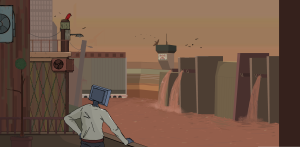
New Hong Kong, the site of the former naval base of the 58th Solarian Fleet, has now developed into a fully fledged city in its own right, being the only prefectural capital with a local synthetic majority. Being less affluent than Suwon or Point Verdant, New Hong Kong is nonetheless a very important centre of interplanetary trade and commercial activity, hosting the planet’s second largest spaceport complex and being the seat of power generation. Large hydroelectric dams and wave energy converters provide employment for a quarter of the city’s inhabitants, the prefecture of New Hong Kong generating enough electricity for domestic consumption as well as exports. Employees of the various power companies may also elect to be sent off to one of the many power generation isles scattered throughout the oceans and dedicated solely to that purpose, receiving better pay in exchange for more dangerous conditions away from home. The city itself is less packed and more planned out than its counterparts, though constant heavy rains and a near permanent gloomy weather place it as undesirable for humans. Seat of the National Party, downtown New Hong Kong is described as the centre of planetary IPC politics, being the first to react to, condemning or appraising events in Konyang and throughout the galactic stage in regards to the synthetic “race”.
Synthetics on Konyang
As the origin of the integrated positronic chassis now found throughout the Orion Spur, Konyang has always had a quite unique relationship with IPCs, the IPC population constituting a staggering 34% of the total population. While IPCs throughout the Sol Alliance are often looked upon as little more than property, tools, or novelties depending upon their frame those found upon Konyang possessed a notably greater degree of autonomy and freedom before the planet’s secession from the rest of the Alliance, achieving full and unconditional freedom afterwards. Legal ownership of synthetics within the borders of the Republic does not exist, the Emancipation Act constituting one of the first acts passed by Parliament. IPCs can work wherever they like, live however they please within the confines of the law, and partake in politics by voting or being elected. As such, foreigners are repeatedly cautioned to not bring any privately held IPCs with them, for they cannot be forced to return unwillingly.
Ordinary Konyangers, as a result of the planet’s liberal outlook on positronics, possess a more positive view of synthetics than other humans in the Orion Spur - particularly those from the Sol Alliance and its former territories. The majority of people on Konyang view IPCs as amicable colleagues and neighbours, with many friendships between man and machine being established. Closer bonds such as marriage are also legalised and not unheard of, though not without outcries from the more conservative spectrum. Many scholars theorize that this is due to the prevalence of IPCs in daily life on Konyang, seamlessly blending into society, in addition to the pride many citizens have in their planet being the origin of the modern positronic. Konyang’s integration of IPCs stands with some degree of contrast to Biesel’s, with the large synthetic ghetto of District 14 segregating many synthetics from the average citizen of the Republic of Biesel.
With Konyang’s independence, IPCs share full legal equality with all organic citizens of the planet. This concession was given, both as an acknowledgement and acceptance of the fact that synthetics have become part of everyday life in the colony and are generally accepted by its inhabitants. Unlike the Republic of Biesel, IPCs in Konyang seek to assimilate into human society, with IPCs being given the choice to adopt a second, “human name” before receiving citizenship. A human name can range from an entirely new name, to adding a first or last name of any kind to their existing designation.
Many positronics can be found within the economy of Konyang with perhaps the most famous (or infamous) one being Gwok-0783 (now Kim Gwok-0783, under post-independence IPC naming conventions), the owner and operator of her very own food conglomerate in the form of Go-Go Gwok! Authentic Konyanger Moss. As Go-Go Gwok! is technically an interstellar corporation, Gwok-0783 herself relied on a series of legal loopholes centered around Konyang’s former IPC laws to maintain control of the company when Konyang was still in the Sol Alliance. Examples such as Gwok, with her control of an inter-planetary corporation, are fairly rare. However, many positronics have made a successful name for themselves as small business owners and corporate workers on Konyang.
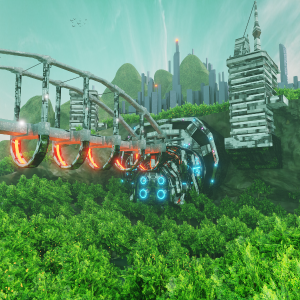
Due to the system’s bluespace gate, many members of Golden Deep have secured permits to operate, as it allows their vessels to more easily make the journey from the frontier to the more lucrative markets of Tau Ceti and the Jewel Worlds. The money and business brought into the system by these synthetic traders has - arguably - been a major contributor to Konyang’s more liberal laws and regulations regarding IPCs. Konyang, before its independence, was one of the few systems under Solarian control in which IPCs could own and operate a business.
The synthetic population in Konyang is regulated by the government. A set number of positronics are assembled each year under contract at Terraneus Diagnostics facilities in Point Verdant with the prospect of being granted citizenship after a 3 month life orientation period. The determined number is set annually by Parliament, backed up by the yearly census and statistics, with production increasing or decreasing depending on the number of human birth ratios, positronic shutdowns, and other factors. Expenses are met both through government funds and private donations, though debate on the matter is rarely heated as the amount of new brains numbers usually in the hundreds; a tiny fraction of positronics produced and exported in total. IPCs and positronics constructed for the purpose of selling them to a different country, are not covered by such regulations and are not given citizenship.
There are further regulations in robotics construction in Konyang. Any activated positronic brain can qualify under the Emancipation Act. Exceptions to the law exist for manufacturing and research, with Point Verdant in particular activating positronic brains for the sake of testing shells before shipping them off-world. The law has also sparked development in other fields of mechatronics, with Konyang beginning to lead the way in circuit-based robotics.
Despite gains for its IPC citizens, other positronic intelligences have not been so lucky. Although some brains have been repurposed as AI coordinators for cities; with no way to transition to humanoid frames, bound intelligences have been granted freedom, but often take contracts with corporations that result in a return to the old status quo, all for the sake of staving off destruction due to a lack of maintenance.
The Trinary Perfection has seen mixed treatment unlike the Golden Deep on Konyang, with the planet’s government conceding that those affiliated with the synthetic church are covered under freedom of religion laws whether they are organic or synthetic. Although this has led to a relatively thriving community for the faith on the planet, with some of its most developed religious centers located on Konyang, the local government has a frigid relationship with the church, owing to its themes of IPC ascendancy running contrary to the local culture of equality.
The most notable locations for the Trinary Perfection on the planet are the Cathedral of the First Positronic and Vault Provenance. The Cathedral of the First Positronic is a holy site that was built by repurposing a nearby vault. Meanwhile Vault Provenance, a name given by the Trinary Perfection clergy, was the vault which held the drones that led to the development of the first positronic brain. Tens of thousands of the Perfection’s faithful make pilgrimages to both sites, and the money these pilgrims inject into Konyang’s economy has been cited as another reason as to why the planet tolerates its presence. Trinary clergy are often educated on Konyang, and many of the highest-ranking officials in the faith were built on the planet.







